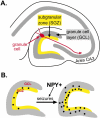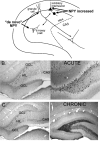Plasticity of neuropeptide Y in the dentate gyrus after seizures, and its relevance to seizure-induced neurogenesis
- PMID: 16383008
- PMCID: PMC4398306
- DOI: 10.1007/3-7643-7417-9_15
Plasticity of neuropeptide Y in the dentate gyrus after seizures, and its relevance to seizure-induced neurogenesis
Abstract
In summary, NPY is clearly an important peptide in the adult rat dentate gyrus because it has the potential to influence synaptic transmission and neurogenesis. It may even have other functions, as yet undiscovered, mediated by glia or vasculature. The remarkable plasticity of NPY puts it in a position to allow dentate gyrus function to be modified in a changing environment. The importance of this plasticity in the context of epilepsy cannot be emphasized enough. It could help explain a range of observations about epilepsy that currently is poorly understood. For example, rapid increases in NPY could mediate postictal depression, the period of depression that can last for several hours after generalized seizures. It may mediate the "priming effect," which is a reduction in seizure threshold following an initial period of seizures. Finally, it could contribute to the resistance of dentate granule cells to degeneration after seizures. However, despite the focus in this review on seizure-induced changes, the changes described here also appear to occur after other types of manipulations, which considerably broadens the scope of NPY's role in the brain.
Figures







References
-
- Abe H, Watanabe M, Yamakuni T, Kuwano R, Takahashi Y, Kondo H. Localization of gene expression of calbindin in the brain of adult rats. Neurosci Lett. 1992;138:211–215. - PubMed
-
- Frederickson CJ, Danscher G. Zinc-containing neurons in hippocampus and related CNS structures. Prog Brain Res. 1990;83:71–84. - PubMed
-
- Gall C, Brecha N, Karten HJ, Chang KJ. Localization ofenkephalin-like immunoreactivity to identified axonal and neuronal populations of the rat hippocampus. J Comp Neurol. 1981;198:335–350. - PubMed
-
- Freund TF, Hajos N, Acsady L, Gores TJ, Katona I. Mossy cells of the rat dentate gyrus are immunoreactive for calcitonin gene-related peptide (CGRP). Eur J Neurosci. 1997;9:1815–1830. - PubMed
-
- Freund TF, Bazsaki G. Intemeurons of the hippocampus. Hippocampus. 1996;6:347–470. - PubMed
Publication types
MeSH terms
Substances
Grants and funding
LinkOut - more resources
Full Text Sources
Medical
Miscellaneous
